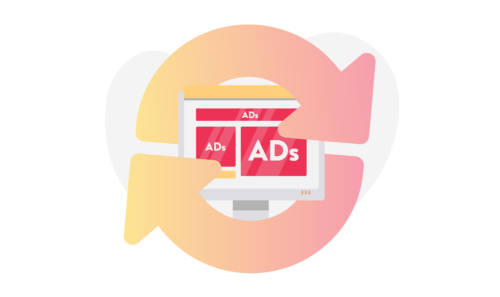Why Page Latency Impacts Google Ads Clicks?
There’s no denying that a successful Publisher needs to put user experience on the same pedestal as revenue streams. Relevant users will remain on a Publisher’s website for a longer period of time only if the desired content loads fast and is not dominated by tons of irrelevant ads. Therefore, unquestionably page latency significantly contributes to user experience, and translates into ad-revenue generation.
We can’t bring up page latency without taking into account its impact on Google Ads Clicks. If you often have a clicks-sessions discrepancy, one of the reasons behind this might be nothing other than page latency. So let’s examine latency itself so as to assess how it impacts your ad inventory; and so as to propose what you can do to minimize the negatives.
What is the page latency?

Page latency is the period of time during which the content on the page will be fully loaded for the user. Page latency can be defined by various factors such as content load delays, ad delivery delays, and more. There are two points we need to consider here. Firstly, bandwidth has nothing to do with page latency. Data transferring from one point to another within a network in a specific amount of time has absolutely no connection with page latency. Secondly, the latency can be easily minimized. Nevertheless, before we’re going to explore different ways of fighting with this serious nightmare of every Publisher, let’s address the negative impact which it has on a website.
Consequences of slowness
According to Google, there are three main attributes related to the clicks-and-sessions issues which the latency can cause:
- Narrowing clicks-sessions discrepancy to a specific Campaign, AdGroup or Keyword is impossible,
- A consistent undercounting of Sessions compared with Clicks is visible across all Google Ad campaigns,
- Segmenting by device e.g.: Desktop, Tablet, Mobile indicates a discrepancy.
Before we move on to the consequences of slowness, I will explain what Short Clicks are. On Google’s support page we can read: “A short click occurs when a user clicks an ad, and then before the Analytics tracking-code request is fired, the user clicks the back button or closes the browser. Google Ads records the click, but a corresponding session is not recorded in Analytics.” As you can see, a slow website can contribute to the appearance of a large number of Short Clicks which results in missing session data or an unnatural low bounce rate. Dealing with high latency means two things for a Publisher: reducing the ad impression rate, and identifying a website as slow in Google Chrome.
A short-term solution to latency
The short-term solution to page latency involves placing the Analytics tracking snippet as high as possible in the HTML (above any other javascript files). The page-render time will be slowed down as the placed tag is an asynchronous JavaScript tag. Basically, it will facilitate the recording of sessions that were missing (Short Clicks). This solution will not work forever. It is extremely important for both user experience and Publisher website performance to treat any solution as a temporary one. Fixing the real-existing problems related to a slow-responding website should be everyone’s priority.
Long-term solutions to latency

There are several long-term solutions to consider while fixing the speed of a website. They are all easy to manage by skilled AdOps teams, but unfortunately they are quite time-consuming. Nevertheless, without the proper configuration of a page setup and an ad load, it will be extremely tough to maximize user sessions; and what follows – a higher ad revenue.
Wisely-managed database
Probably the most important factor which determines the page speed is its database. Key here is to make sure that the database is widely used; and that all images and videos placed on a website are reduced. The overstuffed issue is especially relevant to players who have been on the market for a long time. In this case, the best advice is to clean out the database once a month to make sure that files will not reduce the website speed. New Publishers will also need to keep an eye on all files and ask if they are optimal for web use.
CDN
Content Delivery Network known as CDN is an efficient solution for large Publishers who have users from all over the world. Basically, it stores the data on multiple local servers and serves the data from the server which is closest to the user. CDN will serve fast and efficient content delivery.
Fewer HTTP requests
HTTP requests are nothing other than a demand for delivering the desired action. 80% of a web page’s load time depends on these requests, even though only a small number of the same requests optimize the page speed. Here it is recommended to check how many requests a website gets and remove unnecessary ones.
Fast hosting
Hosting is the heart of any website. Having a low-quality and less specific hosting may cause the slowing down of page-load or even the breaking down of a page. That’s why investing in hosting is of paramount importance.
Campaign setup
Another aspect that might be responsible for slowing down a website but most importantly for revenue and ad latency is a wrong campaign setting. There may be many reasons for this – adding no tag to creatives, or adding too many scripts, putting inconsistent data entry across servers, or choosing the wrong size of creatives and I could go on and on and on. What needs to be done here is to check if all settings are set correctly. Very often, it’s better to outsource skilled experts in order to help you monetize a website properly and run campaigns efficiently.
Fewer redirects
It happens that ads have too many redirects, which might slow down the rendering process of an ad. The problem might be caused by a buy-side partner as well as by fraudulent activities. The best way to avoid redirects is to stop working with problematic partners or watching out for badly-optimized placements.
Header bidding wrappers
Another great solution for a Publisher is a Header Bidding wrapper. A wrapper is a ready-to-use system that not only protects inventory from bid-shading devaluation, but also manages the Programmatic auction before sending the winning bid. The wrapper also allows for elimination of latency created by synchronized calls that usually occur in the waterfall setup. Usually, wrappers designed by trusted partners protect a Publisher from technical issues and from a longer exchange process.
Optimized video ads
Video ads definitely can captivate more than banners. Aspects that make for latency are the time to return a bid, various display issues, or a too large file size that significantly affects the load time. Failing to verify these factors and optimize video ads may mean that a Publisher’s page speed might be seriously affected.
Is latency impacting my website?
If you’re not sure whether latency is impacting your website, there are many tools like Google’s PageSpeed Insights, where you can easily check how fast your page is leading on various devices. Also, we can help you to better understand your current situation; we will also deliver a specific set of recommendations for implementational improvement and streamlining.
Because Yieldbird is part of a large publishing group, we perfectly understand the challenges which Publishers are facing. To this end, we offer a fully managed service where Yieldbird, a trusted partner, takes the responsibility off your shoulder, providing world-class solution-based delivery.






